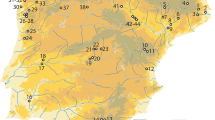Abstract
The grass pea, Lathyrus sativus, has a long record as a food resource in temperate regions of the Old World, despite having toxic seeds and being potentially harmful to both humans and livestock. The seeds are regular components of plant assemblages recovered from archaeological sites in south-west Asia and southern Europe from the seventh millennium BC onwards. The crop has a number of farming advantages, being environmentally tolerant and productive of a palatable, nutritious and easily stored grain, and it is a valued famine food. This paper examines the traditional cultivation and detoxification strategies employed for this important grain crop in the highlands of Ethiopia, and discusses possible lines of evidence that may indicate the use of Lathyrus sativus in the distant past.
Access this chapter
Tax calculation will be finalised at checkout
Purchases are for personal use only
Preview
Unable to display preview. Download preview PDF.
Similar content being viewed by others
References
Abate Tedla and Mohammed Saleem, M.A. (1992). Cropping systems for vertisols of the Ethiopian Highlands. Network Document No 1: Reports and Papers on the Management of Vertisols Addis Ababa: IBSRAM/AFRICALAND, pp. 55–66.
D’Andrea, A. C., Mitiku Haile, Butler, E. A. and Lyons, D. E. (1997). Ethnoarchaeological research in the Ethiopian Highlands. Nyame Akuma 47, 19–26.
D’Andrea, A., Lyons, D., Mitiku Haile, and Butler, A. (this volume). Ethnoarchaeological approaches to the study of prehistoric agriculture in the highlands of Ethiopia. In (M. van der Veen, ed.) The Exploitation of Plant Resources in Ancient Africa New York: Plenum Press.
Asfaw Telaye (1988). Cool season food legumes in East Africa. In ( R. J. Summerfield, ed.) World Crops: Cool Season Food Legumes. Dordrecht: Kluwer, pp. 1113–1124.
Asgelil Dibabe (1995). Grain yield and ODAP content of some grass pea cultivars of Ethiopia. In ( H. K. M. Yusuf and F. Lambein, eds.) Lathyrus sativus and Human Lathyrism: Progress and Prospects. Dhaka, Bangladesh: University of Dhaka, pp. 139–143.
Asgelil Dibabe, Walde Amlak Araia, Bekele Hundie, Regassa Ensermu, Wasie Haile, Yehanew Ashgarie, Asmare Yalew and Wondimagen Seyoum (1994). The status of grass pea (Lathyrus sativus) research in Ethiopia. In ( Berhanu M. Abegaz, Redda Tekle-Haimanot, V.S. Palmer and P.S. Spencer, eds.) Nutrition, Neurotoxins and Lathyrism. New York: Third World Medical Research Foundation, pp. 44–60.
Bell, E. A. (1995). Complementary approaches to the improvement of Lathyrus sativus and the elimination of lathyrism. In ( H. K. M. Yusuf and F. Lambein, eds.) Lathyrus sativus and Human Lathyrism: Progress and Prospects. Dhaka, Bangladesh: University of Dhaka, pp. 249–253.
Bharati, M.P. (1986) Status of Lathyrus sativus among grain legumes cultivated in Nepal. In ( A. K. Kaul and D. Combes, eds.) Lathyrus and Lathyrism. New York: Third World Medical Research Foundation, pp. 142–145.
Boardman, S. (this volume). The agricultural foundation of the Aksumite empire, Ethiopia - an interim report. In (M. van der Veen, ed.) The Exploitation of Plant Resources in Ancient Africa New York: Plenum Press.
Brandt, S. A. (1984) New perspectives on the origins of food production in Ethiopia. In ( J. Desmond Clark and S. A. Brandt, eds.) From Hunters to Farmers. Los Angeles: University of California Press, pp. 173–190.
Butler, E. A. (1991) A mess of pottage: food processing or detoxification of Old World food legumes. Circaea 8, 5–6.
Cohn, D. F. and Streifler, M. (1983). Intoxification by the chickling pea (Lathyrus sativus): nervous system and skeletal findings. Archives of Toxicology. Supplement 6, 190–193.
Crummey, D. (1983). Ethiopian plow agriculture in the nineteenth century. Journal of Ethiopian Studies 16, 1–23. Debela, S. (1989).
Brief remarks on grass pea production in Ethiopia. In (P. S. Spencer, ed.) The Grass Pea. Threat and Promise New York: Third World Medical Research Foundation, pp. 147–151.
Elizabeth Wuhib, Redda Tekle-Haimanot, Angelina Kassina, Yemane Kidane and Tadesse Alemu (1994). Survey on grass pea preparation and general dietary intake in rural communities. In ( Berhanu M. Abegaz, Redda Tekle-Haimanot, V. S. Palmer and P. S. Spencer, eds.) Nutrition, Neurotoxins and Lathyrism. New York: Third World Medical Research Foundation, pp. 119–126.
Gebre Medhin Belay (1992). Conservation Farming in Tigray. Phase 1: Study. Working Paper No. 2. Addis Ababa, Ethiopia: FARMAfrica.
Getachew Addis and Narayan, R. K. J. (1994). Quantitative variation in the amount of neurotoxin, b-N-oxalyl-L-a13-diamino-propionic acid, in Lathyrus sativus during ontogeny. In ( Berhanu M. Abegaz, Redda Tekle-Haimanot, V.S. Palmer and P.S. Spencer, eds.) Nutrition, Neurotoxins and Lathyrism. New York: Third World Medical Research Foundation, pp. 83–88.
Giminez-Roldan, S., Ludolph, A.C., Hugon, J., Hens, M., Kisby, G. E. and Spencer, R. S. (1994). Lathyrism in Spain: progressive central nervous system deficits more than forty-five years after onset? In ( Berhanu M. Abegaz, Redda Tekla-Haimanot, V.S. Palmer and P.S. Spencer, eds.) Nutrition, Neurotoxins and Lathyrism. New York: Third World Medical Research Foundation, pp. 10–25.
Hailu Mekbib, Abebe Demissie and Ababe Tullu (1991). Pulse crops of Ethiopia: genetic resources and their utilization. In ( J. M. M. Engels, J. G. Hawkes and Melaku Worede, eds.) Plant Genetic Resources of Ethiopia. Cambridge: Cambridge University Press, pp. 329–343.
Hillman, G.C. (1984). Interpretation of archaeological plant remains: the application of ethnographic models from Turkey. In ( W. van Zeist and W. A. Casparie, eds.) Plants and Ancient Man. Rotterdam: Balkema, pp. 1–41.
Holt, J. and Lawrence, M. (1993). Making Ends Meet. A Survey of the Food Economy of the Ethiopian North-East Highlands. London: Save the Children UK.
Hubbard, R. N. L. B. (1979). Ancient agriculture and ecology at Servia, Appendix 2. In ( C. Ridley and K. A. Wardle, eds.) Rescue Excavations at Servia. Annual of the British School at Athens 74, pp. 226–228.
Hussain, M. and Chowdhury, B. (1995) Agro-ecological factors affecting the concentration of b-N-oxalyl-a-bdiaminopropionic acid (ODAP) in Lathvrus sativus seeds. In ( H. K. M. Yusuf and F. Lambein, eds.) Lathvrus sativus and Human Lathyrism: Progress and Prospects. Dhaka, Bangladesh: University of Dhaka, pp. 201–209.
Johansen, C., Baldev, B., Brouwer, J. B., Erskine, W., Jermyn, W. A., Li-Juan, L., Malik, B.A., Ahad Miah, A. and Silim, S. N. (1994). Biotic and abiotic stresses constraining productivity of cool season food legumes in Asia, Africa and Oceania. In ( F. J. Muelbauer and W. J. Kaiser, eds.) Expanding the Production and Use of Cool Season Food Legumes. Dordrecht: Kluwer, pp. 175–194.
Jones, G. E. M. (1994). Interpretation of archaeological plant remains: ethnographic models from Greece. In ( W. van Zeist and W. A. Casparie, eds.) Plants and Ancient Man. Rotterdam: Balkema, pp. 43–61.
Kaul, A., Islam, M. Q. and Hamid, A. (1986). Screening of Lathvrus germplasm of Bangladesh for BOAA content and some agronomic characters. In ( A. K. Kaul and D. Combes, eds.). Lathyrus and Lathyrism. New York: Third World Medical Research Foundation, pp. 130–14I.
Kelbesa Urga, Alemu Fite and Mengistu Gebre Tsadik (1994). Influence of processing methods on cooking time and nutritional quality of grass pea. In ( Berhanu M. Abegaz, Redda Tekle-Haimanot, V.S. Palmer and P.S. Spencer, eds.) Nutrition, Neurotoxins and Lathyrism. New York: Third World Medical Research Foundation, pp. 105–118.
Kislev, M. E. (1986). Archaeobotanical findings on the origin of Lathyrus sativus and L. cicera. In ( A. K. Kaul and D. Combes, eds.) Lathyrus and Lathyrism. New York: Third World Medical Research Foundation, pp. 46–51.
Kislev, M. E. (1989). Origins of the Cultivation of Lathyrus sativus and L. cicera (Fabaceae). Economic Botany 43, 262–270.
Kuo, Y-H., Khan, J. K. and Lambein, F. (1994). Biosynthesis in vivo of the neurotoxin b-ODAP in Lathyrus sativus. In ( Berhanu M. Abegaz, Redda Tekle-Haimanot, V.S. Palmer and P.S. Spencer, eds.) Nutrition, Neuro-toxins and Lathyrism. New York: Third World Medical Research Foundation, pp. 15–20.
McCann. J. C. (1995). People of the Plow. Madison, Wisconsin: University of Wiscons in Press.
Pandey, R. L. and Kashyap, O. R. (1995). Studies on socio-economic strata and Lathvrus consumption in rural Madhya Pradesh. In ( H. K. M. Yusuf and F. Lambein, eds.) Lathvrus sativus and Human Lathyrism: Progress and Prospects. Dhaka, Bangladesh: University of Dhaka, pp. 47–50.
Phillipson, D. W. (1993). African Archaeology, 2nd Edition. Cambridge: Cambridge University Press.
Redda Tekle-Haimanot (1989). Lathyrism in Ethiopia. In ( R S. Spencer, ed.) The Grass Pea: Threat and Promise. New York: Third World Medical Research Foundation, pp. 36–40.
Redda Tekle-Haimanot, Yemane Kidane, Elizabeth Wuhib, Angelina Kassib, Tadesse Alemu, Zein Ahmed Zein and Spencer, P. S. (1990). Lathyrism in rural Northwestern Ethiopia: a highly prevalent neurotoxic disorder. International Journal of Epidemiology. 19, 664–672.
Redda Tekle-Haimanot, Yemane Kidane, Elizabeth Wuhib, Angelina Kassina, Yohannes Endeshaw, Tadesse Alemu and Spencer, R. S. (1994). The epidemiology of lathyrism in Ethiopia. In ( Berhanu M. Abegaz, Redda Tekle-Haimanot, V. S. Palmer and P.S. Spencer, eds.) Nutrition. Neurotoxins and Lathyrism. New York: Third World Medical Research Foundation, pp. 1–9.
Redda Tekle-Haimanot, Berhanu Abegaz, Elizabeth Wuhib, Angelina Kassib, Yemane Kidane, Naod Kebede, Tadesse Alemu and Spencer, P. S. (1995).
Nutritional and neuro-toxicological surveys of Lathyrus sativus consumption in Northern Ethiopia. In (H. K. M. Yusuf and F. Lambein, eds.) Lathyrus sativus and Human Lathyrism: Progress and Prospects Dhaka, Bangladesh: University of Dhaka, pp. 41–45.
Simon Adebo (1993). Report of Diagnostic Survey of Debri Tabia in Enderta Wereda. Internal Report. Addis Ababa, Ethiopia: FARMAfrica.
Simoons, F. J. (1960). Northwest Ethiopia. Madison, Wisconsin: University of Wiscons in Press.
Smartt, J., Kaul, A., Wolde Amlak Araya, Rahman, M. M. and Kearney, J. (1994). Grass pea (Lathyrus sativus L.) as a potentially safe legume food crop. In (F. J. Muelbauer and W. J. Kaiser, eds.) Expanding the Production and Use of Cool Season Food Legumes. Dordrecht: Kluwer, pp. 144–155.
Westphal, E. (1974). Pulses in Ethiopia, Their Taxonomy and Agricultural Significance. Wageningen: Centre for Agricultural Publishing and Documentation, PUDOC.
Westphal, E. (1975). Agricultural Systems in Ethiopia. Wageningen: Centre for Agricultural Publishing and Documentation, PUDOC.
Zohary, D. and Hopf, M. (1994). Domestication of Plants in the Old World. 2nd edition, paperback. Oxford: Clarendon Press.
Author information
Authors and Affiliations
Editor information
Editors and Affiliations
Rights and permissions
Copyright information
© 1999 Springer Science+Business Media New York
About this chapter
Cite this chapter
Butler, A., Tesfay, Z., D’Andrea, C., Lyons, D. (1999). The Ethnobotany of Lathyrus Sativus L. in the Highlands of Ethiopia. In: van der Veen, M. (eds) The Exploitation of Plant Resources in Ancient Africa. Springer, Boston, MA. https://doi.org/10.1007/978-1-4757-6730-8_11
Download citation
DOI: https://doi.org/10.1007/978-1-4757-6730-8_11
Publisher Name: Springer, Boston, MA
Print ISBN: 978-1-4419-3316-4
Online ISBN: 978-1-4757-6730-8
eBook Packages: Springer Book Archive




